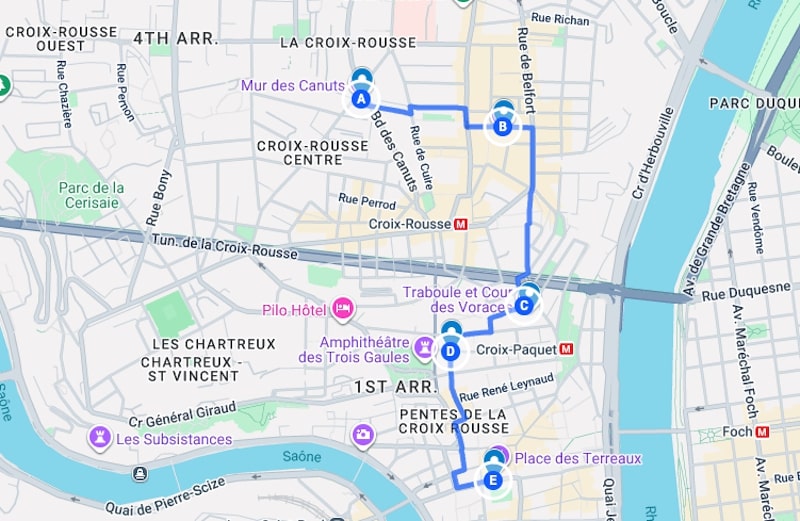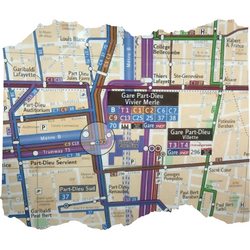Fascinated by Gallo-Roman history? Click Here to download > > > Here are 6 ways Rome affected France
- Home ›
- Destinations ›
- Lyon ›
- La Croix-Rousse
Croix-Rousse, Lyon Itinerary: In The Footsteps Of The City's Silk Heritage
Updated 13 September 2025 by Leyla Alyanak — Parisian by birth, Lyonnaise by adoption, historian by passion
Silk shaped Lyon’s economy and identity for more than four centuries. This walking itinerary takes you through Croix Rousse, Lyon, the historic silk-weaving district that shaped the city’s identity.
What is the first thing that springs to mind when you hear "Lyon"? Is it...
- Lyon's culinary reputation as France's foodie capital?
- The city's iconic (and huge) hand-painted murals?
- The famous secret passageways, or traboules, that dot the city's older areas
- The name Lugdunum, capital of Gaul at the time of Roman domination?
If you guessed any of these, you'd be right.
But you'd also be missing a major highlight of Lyon: the silk workers, or canuts, to whom Lyon owes its power and wealth.
Here, then, is an itinerary that takes you along the canuts' homes and workplaces on Croix-Rousse hill, known as the colline qui travaille (“the hill that works”) as opposed to Fourvière, "the hill that prays".
This hill was the center of Lyon’s silk trade for centuries, its canuts producing fabrics coveted across Europe. It was also where the workers staged the first major labor revolts in France in 1831 and 1834, foretelling France's later episodes of unrest.
1. Mur des Canuts – silk heritage in murals
2. Maison des Canuts – where Lyon’s silk story begins
3. Cour des Voraces – traboules and revolution
4. Montée de la Grande-Côte – the canuts’ path to the city
5. Place des Terreaux – seat of power and site of revolt
The bouchons lyonnais - eating traditional food
Wandering the streets of Croix-Rousse, Lyon
NOTE: Pages on this site may contain affiliate links, which support this site. See full Privacy Policy here.
Croix-Rousse: In the footsteps of the canuts
The Croix-Rousse district remains one of Lyon’s most distinctive areas, with its steep streets and hidden passageways, and its buildings and courtyards preserving the memory of its silk heritage.
If you follow the itinerary below, you’ll see the traces of this history in the buildings, courtyards, and museums that preserve the memory of the canuts, Lyon’s traditional silk workers.
1. Mur des Canuts – silk heritage in murals
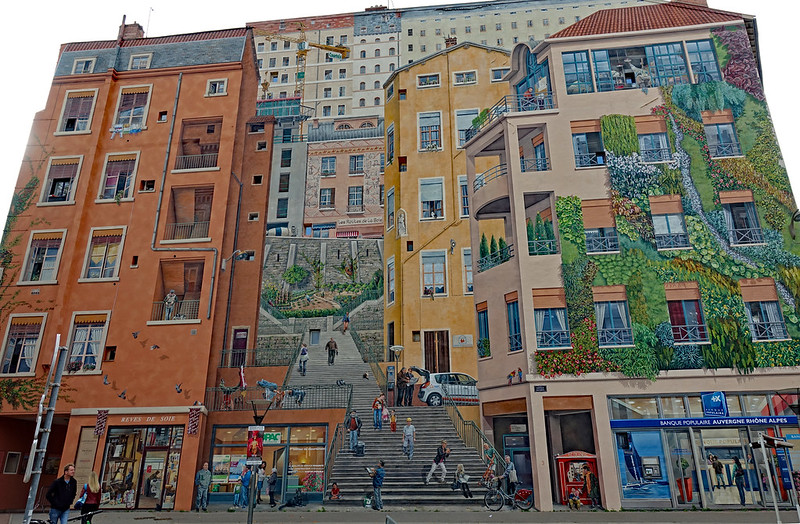
📍 Boulevard des Canuts, 69004 Lyon
Begin your walk at the Mur des Canuts, the immense trompe-l’œil mural that celebrates the life and work of Lyon’s silk weavers. It covers an entire building on Boulevard des Canuts, fittingly named after the workers themselves, and is one of the largest painted walls in Europe.
To get here, take Metro line C to Henon station; walk down the Boulevard (keep the pharmacy on your right) and it’s just a short walk. You'll see the wall in the distance on your right.
Look closely at the mural. Are you seeing a painted fresco or a slice of daily life?
Look again and you’ll notice scenes from Lyon’s silk-making history woven into the composition. It’s so detailed you could study it for an hour and still not catch everything.
The mural has been repainted several times since its creation in the 1980s, each version updated to reflect changes in the neighborhood. So, in a way, it’s a living document of silk heritage in Croix-Rousse Lyon.
2. Maison des Canuts – where Lyon’s silk story begins
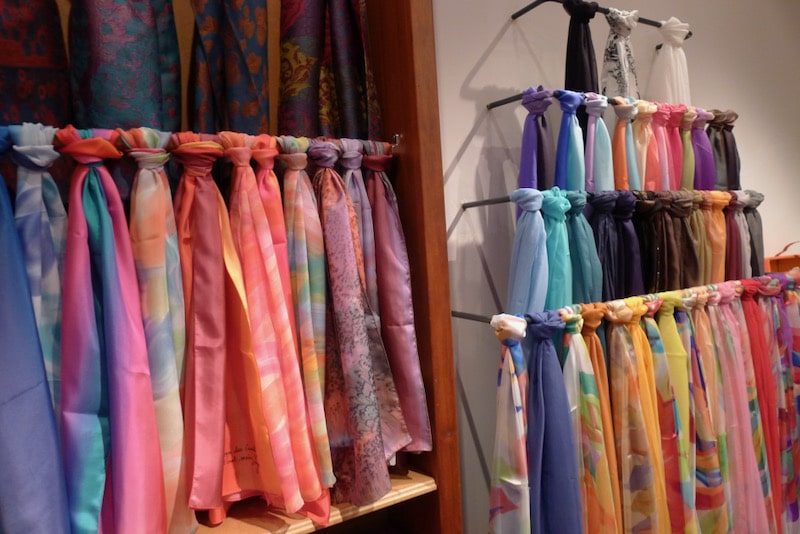
📍 10–12 rue d’Ivry, Croix-Rousse
From the mural, it’s just a short walk to the Maison des Canuts, a former cooperative turned museum that tells the story of Lyon’s silk industry.
The Maison des Canuts provides a fascinating visit, not only about the history of silk in Croix-Rousse and Lyon more generally but on the weaving process; much machinery is still in working order and demonstrations will help you understand just how much was involved in preparing that precious scarf when everything was made by hand.
The museum also covers the canut rebellions, the 1831 and 1834 uprisings that shook Lyon and marked the first major strikes in France. (You can read more about these events on my Substack story.)
Visitor tip: Guided tours are primarily in French, although the museum often provides printed explanations in English. Allow 30-45 minutes.
3. Cour des Voraces – traboules and revolution
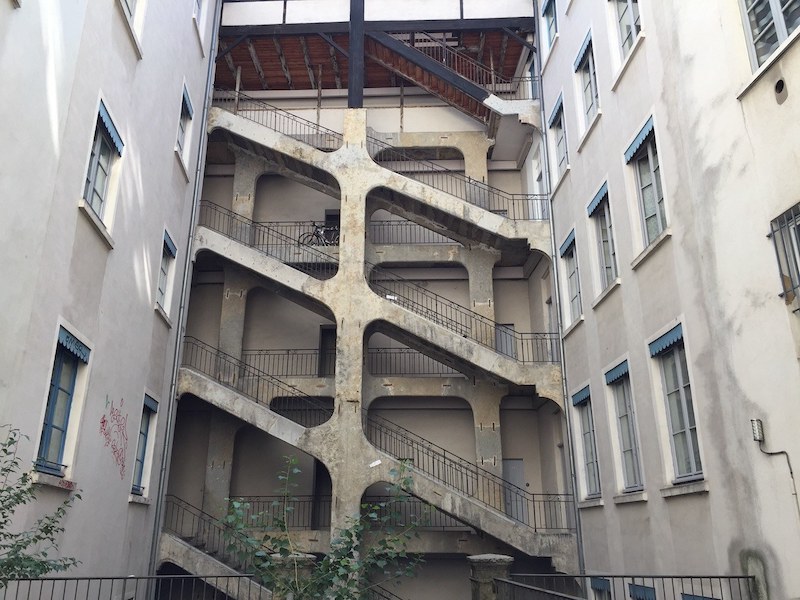
📍 Entry at 9 Place Colbert or 14 bis Montée Saint-Sébastien
Next, visit the Cour des Voraces, the most famous traboule in Lyon. Traboules are passageways that allowed workers to carry bolts of silk downhill without exposing them to rain, and they became escape routes during uprisings.
Not only is it one of the area’s longest passageways, but it played a role when the silk weavers rebelled in their fight for better working conditions. The Voraces also has links to the French resistance during World War II, helping rebels escape the Nazis who then occupied Lyon.
Most signs on the traboule map point to the Place Colbert but once here, the signs become scarce, so look for a discreet plaque that's easy to miss.
The Cour des Voraces is not a traboule in the traditional sense. While traboules are typically covered passageways that cut through city blocks, the Cour des Voraces is an open interior courtyard with a monumental staircase connecting different streets. It is universally included on traboule maps and is a must-see, but technically it's a "cour", a courtyard.
4. Montée de la Grande-Côte – the canuts’ path to the city
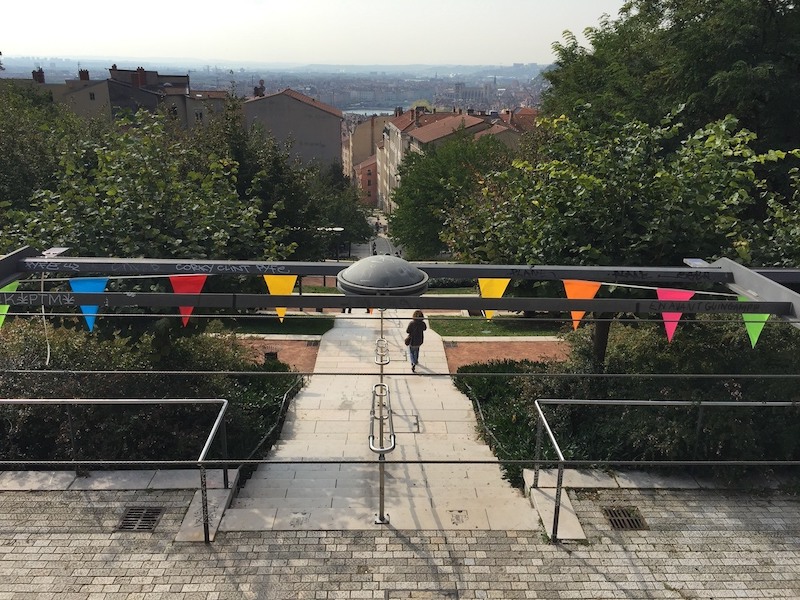
📍 Runs between Place des Terreaux and Croix-Rousse
The Montée de la Grande-Côte is the historic artery between the silk workshops above and the merchants below. In November 1831, the first clashes of the canut revolt broke out here.
Walk down the hill along the street, now partly pedestrian and lined with shops and eateries, and side streets that twist and darken into the distance.
5. Place des Terreaux – seat of power and site of revolt
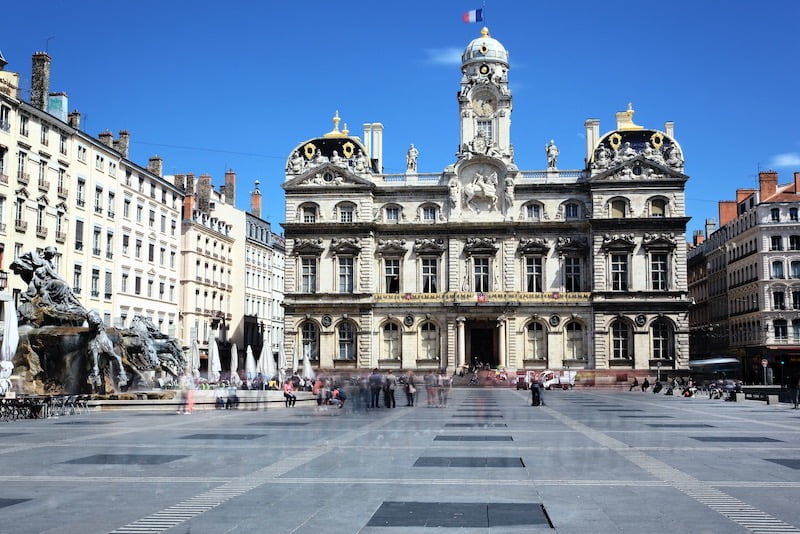
📍 Place des Terreaux, 69001 Lyon
At the base of the Grande-Côte lies Place des Terreaux, framed by the Hôtel de Ville on one side and the Musée des Beaux-Arts on the other. In 1831, the silk workers briefly took control of this square and of City Hall itself, before the army retook Lyon.
The square’s focal point today is the Bartholdi fountain, added in 1891, but its role in the canut revolts makes it one of the essential stops on this itinerary and a fitting end to your walk.
The bouchons lyonnais - eating traditional food
This one is not on the itinerary because you can try any of the many bouchons in Lyon, and you'll find them scattered throughout Croix-Rousse, Old Lyon, and the Presqu'île. (Here's a selection, in French.)
No walk through Croix-Rousse is complete without a stop at a traditional bouchon, the working-class restaurants that once fed the silk workers. Typical fare includes pork-based dishes, hearty gratins, and the local specialty cervelle de canut, which translates into silk workers' brains, but it's actually a fresh cheese with herbs and garlic.
It is believed that the bouchons were initially opened to feed silk workers a mid-morning snack – potatoes, herring or cod or anything pig-related, often left over from dinner the night before. The woman would be in the kitchen (of course) and the man would handle service and the wine cellar. These women eventually went on to become some of Lyon's most famous chefs.
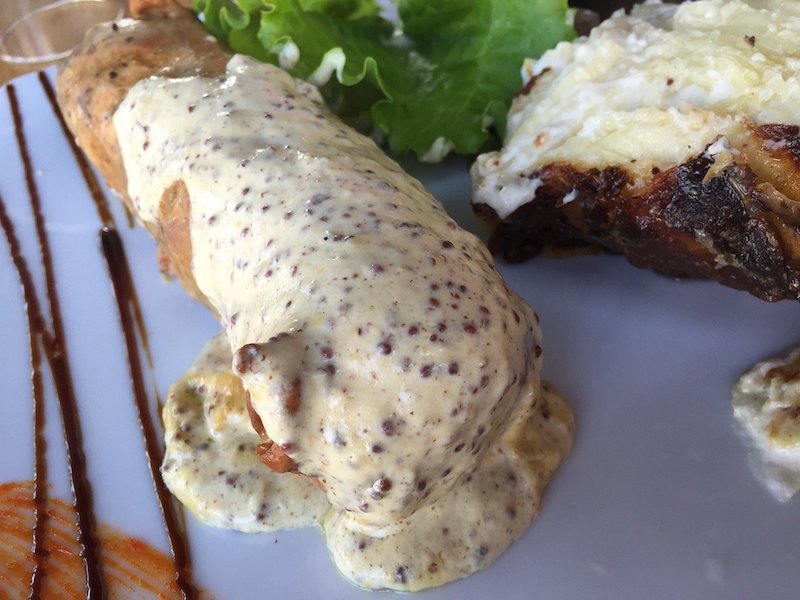 More to the point is what in inside, on the plate: a classic Andouillette with mustard cream sauce and a Gratin Dauphinois, not light, but exquisite
More to the point is what in inside, on the plate: a classic Andouillette with mustard cream sauce and a Gratin Dauphinois, not light, but exquisiteFor a Croix-Rousse option, the Café du Gros Caillou sits near the big rock landmark at the top of the hill. Otherwise, head downhill into Presqu’île for one of Lyon’s many historic establishments.
Wandering the streets of Croix-Rousse, Lyon
Croix-Rousse was a once-independent village so proud that today, more than 150 years after it joined Lyon, its residents still call themselves Croix-Roussiens, not Lyonnais. That sense of identity remains strong today.
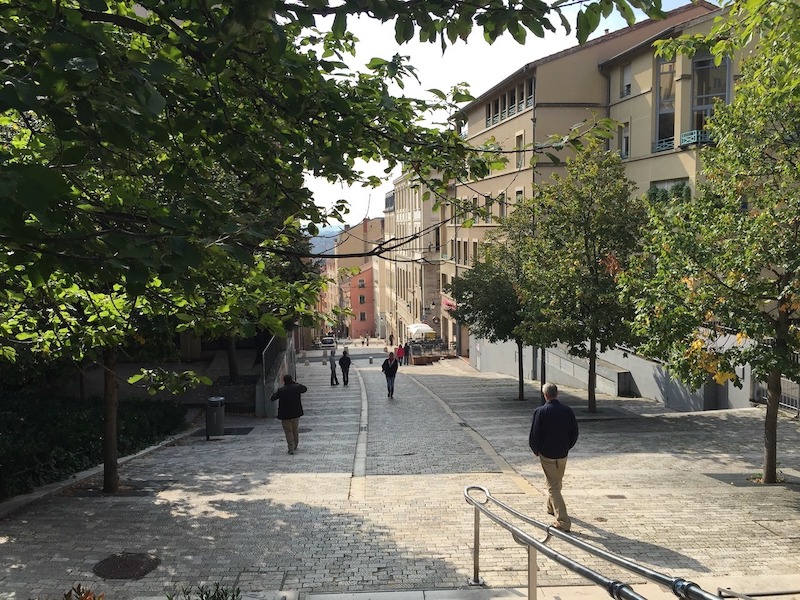 Looking down towards Lyon from halfway up the Croix-Rousse
Looking down towards Lyon from halfway up the Croix-Rousse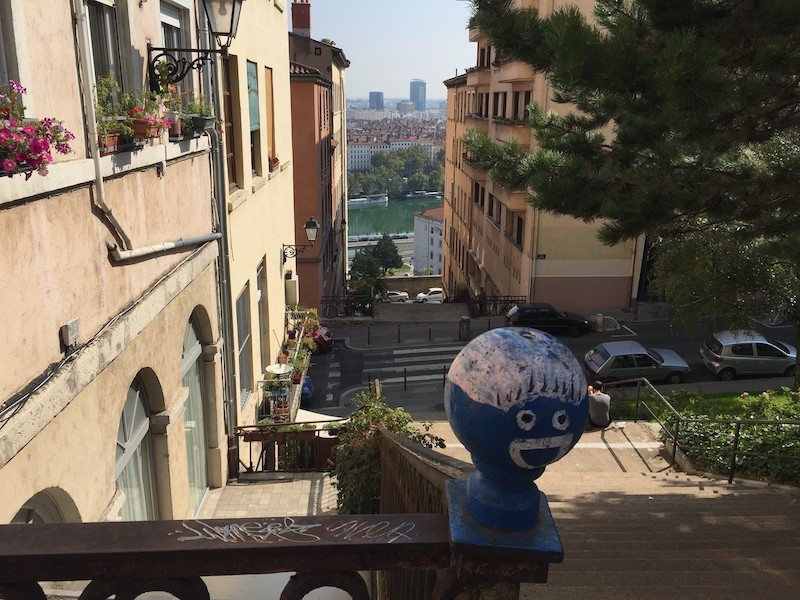
For centuries Croix-Rousse was the heart of Lyon’s silk trade, and Lyon the European capital of silk.
Silk is everywhere: in local food traditions (cervelle de canut, a garlic-herb cheese spread named after the workers), in the guignol puppet theater that began as canut entertainment, and in the bouchons that first served them.
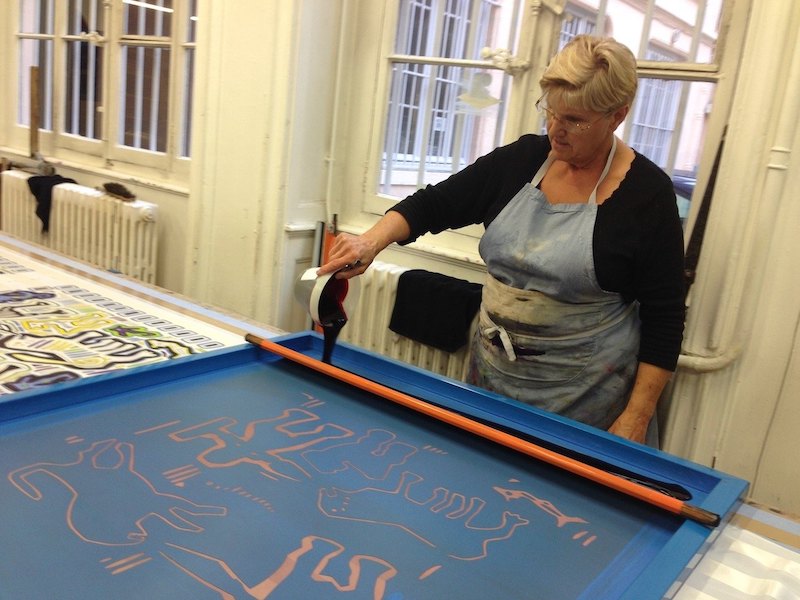 Silk-screener at work in Croix-Rousse, Lyon
Silk-screener at work in Croix-Rousse, LyonYou’ll find plenty of silk shops across Croix-Rousse and Old Lyon — Brochier Soieries and Soierie Saint-Georges are among the best known, while smaller ateliers like Sophie Guyot carry on the craft with modern designs.
Before you go...
Even if you’ve visited Lyon before, you may never have ventured beyond the refurbished old town or the shopping boulevards. Yet understanding Lyon’s history inevitably brings you here, to the Croix-Rousse — the hill that works, where silk shaped both the city’s fortunes and its labor history.
Croix-Rousse is not just another neighborhood in Lyon.
It is where silk created fortunes, and where the canuts lived and worked, not to mention the site of the first great strikes in France.
They say Lyon was built on silk, but they must actually mean Croix-Rousse because this, after all, is Lyon's heart of silk.
This half-day itinerary links the daily life of 19th-century workers to today's city, and following in their footsteps is one of the most culturally rewarding things to do in Lyon.
Ready for your Lyon trip?
Here are some suggestions to make your visit even more enjoyable!
TOP LYON CITY TOURS
➽ Vieux Lyon 4-hour Food Tasting Tour - for inveterate foodies and gastronomes
➽ Discover Lyon Walking Tour - to explore the essence of the city
LYON DAY TRIPS
➽ Golden Stones Beaujolais - heart of the Golden Stone villages for wine lovers
➽ Northern Côtes du Rhône - meeting the winemakers
➽ Beaujolais and Pérouges - wine tasting and a medieval village visit
WHERE TO STAY IN LYON
➽ Villa Florentine - stunning 5-star luxury overlooking the entire city
➽ Mi-Hotel Tour Rose - perfect apartments in historic Vieux Lyon
➽ Fourvière Hotel - elegant simplicity in a former cloister
➽ Hotel du Théatre - budget option in the heart of the classical district
Renting a car in Lyon? Compare prices here.
Traveling here by train? Book your ticket here.
To see the city, don't forget to book your Lyon City Card.
Did you enjoy this article? I'd love if you shared it!
